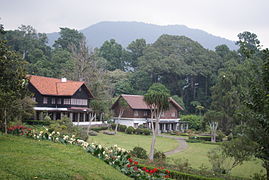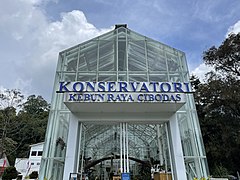Cibodas Botanical Garden
| Cibodas Botanical Garden | |
|---|---|
| Kebun Raya Cibodas | |
 Entrance to Cibodas Botanical Garden | |
 | |
| Type | Botanic Garden |
| Location | Cimacan Village, Cianjur Regency, West Java |
| Area | 84.99 hectares (210.0 acres; 0.8499 km2) |
| Created | April 11, 1852 |
| Founder | Johannes Elias Teijsmann |
| Operated by | Indonesian Institute of Sciences |
| Status | Open |
| Website | kebunraya.id/cibodas |
Cibodas Botanical Garden (Indonesian: Kebun Raya Cibodas, KRC) is a 84.99 hectares (210.0 acres) botanical garden on the slopes of Mount Gede, located in the Cibodas subdistrict of West Java, Indonesia.[1] It was operated by the Indonesian Institute of Sciences (LIPI), which now has been transformed into the National Research and Innovation Agency (BRIN).[2]
History
[edit]The garden was founded in 1852 by the Dutch botanist Johannes Elias Teijsmann as a branch of the Bogor Botanical Gardens, and its layout was completed under Rudolph Scheffer in later years.[3]
Overview
[edit]
The gardens were built at a high elevation, allowing the growth of subtropical plants.[3] The garden is approximately 1,300–1,425 metres (4,265–4,675 ft) above mean sea level, with an average temperature across the year of 20.06 °C, and an average humidity of 80.82%.
The gardens are the first place where Cinchona trees were grown in Indonesia for quinine production in 1854. The trees were originally brought to Java by Justus Carl Hasskarl from South America and were successfully experimented with in the garden.[4] Plants that are exotic to Indonesia, such as Eucalyptus from Australia, Conifers from Europe, and others are cultivated in the area.[5]
Collection
[edit]
There are approximately 10,792 living specimens in the garden, including 320 orchids, 289 cacti, 22 succulent plants, 216 algae, 103 ferns, and 1162 garden plant species that live within the proximity of the botanic garden. Only 114 of the plant species present in the garden are native to West Java. Its herbarium contains approximately 4,852 preserved specimens of plants.[6]
The collections are divided into outdoor and indoor sections. The indoor section houses plants within glasshouses, including cacti and orchids. The outdoor section is divided into a sakura garden, algae garden, rhododendron garden, fern garden, and medicine garden.[7]
In April 2014, the botanic garden opened a new section, the House of Nepenthes (Rumah Kantung Semar), containing 55 species and 47 hybrid species of Nepenthes.[8]
Cibodas Bryophyte Park
[edit]The Cibodas bryophyte park, or Taman Lumut Cibodas, is part of the Cibodas Botanical Garden and is located between Mount Gede and Mount Gede Pangrango National Park.[9] It was built in 2004 and opened to the public officially on April 11, 2006, on the occasion of the 154th anniversary of the Cibodas Botanical Gardens. The 1,500 m2 garden was designed to resemble the natural habitat of mosses. Natural shade is also provided by the shade of native Indonesian plants that grow around it to give the desired humid conditions.[10]
Gallery
[edit]-
Main Pond at Cibodas Botanical Garden
-
Green Area at Cibodas Botanical Garden
-
Guest houses
-
The conservatory building at Cibodas Botanical Garden
-
Cibodas Botanical Garden main office
See also
[edit]References
[edit]- ^ Farah Fitriani, 'See the World in Cibodas Botanical Garden' Archived 2016-03-03 at the Wayback Machine on the Good news from Indonesia website, posted 11 January 2011.
- ^ "Struktur Organisasi BRIN". BRIN. Retrieved 2022-08-29.
- ^ a b Sejarah Cibodas Archived 2015-02-17 at the Wayback Machine, krcibodas.lipi.go.id
- ^ Audrey Kahin; R. B. Cribb (2004). Historical Dictionary of Indonesia. Scarecrow Press. p. 80. ISBN 9780810849358. Archived from the original on January 24, 2022. Retrieved February 26, 2015.
- ^ "Archived copy". Archived from the original on 2015-02-18. Retrieved 2015-02-18.
{{cite web}}: CS1 maint: archived copy as title (link) - ^ Kebun Raya Cibodas Archived 2017-07-04 at the Wayback Machine, disparbud.jabarprov.go.id
- ^ Kebun Raya Cibodas Wahana Wisata dan Penelitian Archived 2019-11-23 at the Wayback Machine , Koran Jakarta, 14 February 2015.
- ^ "Intip Tanaman Khas dari Kebun Raya Cibodas – PesonaWisata.©". Archived from the original on 2016-03-13. Retrieved 2015-02-18.
- ^ "World's Biggest Moss Garden Opens". Archived from the original on 20 November 2016. Retrieved 19 November 2016.
- ^ "Taman Lumut". Archived from the original on 28 August 2017. Retrieved 19 November 2016.






